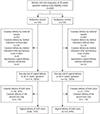1. Barrett JF, Hannah ME, Hutton EK, Willan AR, Allen AC, Armson BA, et al. A randomized trial of planned cesarean or vaginal delivery for twin pregnancy. N Engl J Med. 2013; 369:1295–1305.

2. Schmitz T, Carnavalet Cde C, Azria E, Lopez E, Cabrol D, Goffinet F. Neonatal outcomes of twin pregnancy according to the planned mode of delivery. Obstet Gynecol. 2008; 111:695–703.

3. Hoffmann E, Oldenburg A, Rode L, Tabor A, Rasmussen S, Skibsted L. Twin births: cesarean section or vaginal delivery? Acta Obstet Gynecol Scand. 2012; 91:463–469.

4. Weisz B, Hogen L, Yinon Y, Mazaki S, Gindes L, Schiff E, et al. Mode of delivery and neonatal outcome in uncomplicated monochorionic twin pregnancies. J Matern Fetal Neonatal Med. 2012; 25:2721–2724.

5. Barrett JF. Twin delivery: method, timing and conduct. Best Pract Res Clin Obstet Gynaecol. 2014; 28:327–338.

6. Blickstein I, Zalel Y, Weissman A. Cesarean delivery of the second twin after the vaginal birth of the first twin: misfortune or mismanagement? Acta Genet Med Gemellol (Roma). 1991; 40:389–394.

7. Korb D, Deneux-Tharaux C, Seco A, Goffinet F, Schmitz T. JUmeaux MODe d'Accouchement (JUMODA) study group and the Groupe de Recherche en Obstétrique et Gynécologie (GROG). Risk of severe acute maternal morbidity according to planned mode of delivery in twin pregnancies. Obstet Gynecol. 2018; 132:647–655.

8. Suzuki S, Kikuchi F, Ouchi N, Nagayama C, Nakagawa M, Inde Y, et al. Risk factors for postpartum hemorrhage after vaginal delivery of twins. J Nippon Med Sch. 2007; 74:414–417.

9. Ishikawa K, Ikeda T, Miyazaki R. Cesarean delivery and perinatal mortality rates in Japan, 2007–2011. J Matern Fetal Neonatal Med. 2014; 27:994–999.

11. Schachter-Safrai N, Karavani G, Haj-Yahya R, Ofek Shlomai N, Porat S. Risk factors for cesarean delivery and adverse neonatal outcome in twin pregnancies attempting vaginal delivery. Acta Obstet Gynecol Scand. 2018; 97:845–851.

12. Razavi AS, Chasen ST, Chambers F, Kalish RB. Induction of labor in twin gestation: can we predict success? J Perinat Med. 2018; 46:771–775.

13. Grobman WA, Dooley SL, Peaceman AM. Risk factors for cesarean delivery in twin gestations near term. Obstet Gynecol. 1998; 92:940–944.

14. Levine EM, Ghai V, Barton JJ, Strom CM. Mode of delivery and risk of respiratory diseases in newborns. Obstet Gynecol. 2001; 97:439–442.

15. Derbent A, Tatli MM, Duran M, Tonbul A, Kafali H, Akyol M, et al. Transient tachypnea of the newborn: effects of labor and delivery type in term and preterm pregnancies. Arch Gynecol Obstet. 2011; 283:947–951.

16. Silver RK, Haney EI, Grobman WA, MacGregor SN, Casele HL, Neerhof MG. Comparison of active phase labor between triplet, twin, and singleton gestations. J Soc Gynecol Investig. 2000; 7:297–300.

17. Schiff E, Cohen SB, Dulitzky M, Novikov I, Friedman SA, Mashiach S, et al. Progression of labor in twin versus singleton gestations. Am J Obstet Gynecol. 1998; 179:1181–1185.

18. Fausett MB, Barth WH Jr, Yoder BA, Satin AJ. Oxytocin labor stimulation of twin gestations: effective and efficient. Obstet Gynecol. 1997; 90:202–204.
19. de Castro H, Haas J, Schiff E, Sivan E, Yinon Y, Barzilay E. Trial of labour in twin pregnancies: a retrospective cohort study. BJOG. 2016; 123:940–945.

20. Algeri P, Callegari C, Bernasconi DP, Incerti M, Cozzolino S, Paterlini G, et al. Neonatal hypoxia of the second twin after vaginal delivery of the first twin: what matters? J Matern Fetal Neonatal Med. 2019; 32:2889–2896.

21. Suzuki S. Vagibal delivery of twins based on the reports of the Japan Obstetric Compensation System. J Jpn Soc Perin Neon Med. 2018; 54:1483–1484.
22. Vayssière C, Benoist G, Blondel B, Deruelle P, Favre R, Gallot D, et al. Twin pregnancies: guidelines for clinical practice from the French College of Gynaecologists and Obstetricians (CNGOF). Eur J Obstet Gynecol Reprod Biol. 2011; 156:12–17.

23. Arabin B, Kyvernitakis I. Vaginal delivery of the second nonvertex twin: avoiding a poor outcome when the presenting part is not engaged. Obstet Gynecol. 2011; 118:950–954.
24. Kathpalia SK, Chawla J, Harith AK, Gupta P, Anveshi A. Blood transfusion practices among delivery cases: a retrospective study of two years. Med J Armed Forces India. 2016; 72:S43–5.

25. Suzuki S. Association of intended route of delivery and maternal morbidity in twin pregnancy. Obstet Gynecol. 2017; 129:1135.

26. Suzuki S, Inde Y, Igarashi M, Miyake H. Elective cesarean as a risk factor for transfusion after delivery of twins. J Nippon Med Sch. 2008; 75:247–249.

27. Roach MK, Abramovici A, Tita AT. Dose and duration of oxytocin to prevent postpartum hemorrhage: a review. Am J Perinatol. 2013; 30:523–528.








 PDF
PDF ePub
ePub Citation
Citation Print
Print




 XML Download
XML Download